| "Descrizione" by Street82 (2970 pt) | 2024-Jan-17 16:53 |
Review Consensus: 10 Rating: 10 Number of users: 1
| Evaluation | N. Experts | Evaluation | N. Experts |
|---|---|---|---|
| 1 | 6 | ||
| 2 | 7 | ||
| 3 | 8 | ||
| 4 | 9 | ||
| 5 | 10 |
Methylparaben is a 4-hydroxybenzoate ester of p-hydroxybenzoic acid
Appears in the form of a white powder. Stable. Incompatible with strong bases and strong oxidising agents.
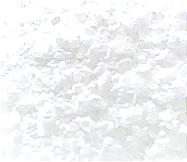
It is a preservative additive, belonging to the paraben family, used in various industries and serves to fight bacteria, fungi, yeasts and moulds. Like all esters and salts of the Paraben class, it is also often found in cosmetic, pharmaceutical and food formulations.
It is listed with the number E218 in the European food additives list as a preservative.
Methylparaben (MP) is used to extend the shelf life of industrial chemicals (Cashman and Warshaw, 2005). However, when the skin is exposed to MP, this compound permeates the epidermis and dermis and shows in particular greater permeation than other parabens due to the difference in their lipophilicity ( El Hussein et al., 2007 ). It exhibits several adverse dermatological reactions, such as allergic reaction, the cytotoxic synergistic effect of UV radiation and the development of breast cancer ( Nardelli et al., 2009 , Dagher et al., 2012 ). MP concentrations above 4 mg ml -1 in industrial products are known to be harmful ( Darbre and Harvey, 2008; CIR Expert Group, 2008 ). Although MP persists in the dermis ( El Hussein et al., 2007 ), little is known about its side effects or molecular mechanism in the dermis.
Studies
Overall, the results show that MP induces cellular senescence in vitro and in vivo, via the GR-c-Jun-ROS pathway, and MP-induced cellular senescence alters ECM components. Although the treatment doses of MP used in this study seem high compared to the limit of industrial use (CIR Expert Group, 2008), the data provide evidence for the hypothesis that MP overdose may induce alterations in ECM components by concentrating senescent fibroblasts in the dermis (1).
Methylparaben is, like all parabens, a debated component about whose safety many doubts have been raised, in particular because of the damage it would cause to the aquatic environment where it is discharged after use (2).

Exposure to methylparaben has been associated with adverse health outcomes and exposure to ultraviolet rays may amplify its toxicity (3).
To reduce the toxicity of parabens in the aquatic environment, a system called the Fenton process is applied (4).
Clinical studies have suggested that Methylparaben increases breast cancer proliferation and may play a direct role in chemoresistance by modulating stem cell activity (5).
Parabens, but in particular Methylparaben, promotes adipogenesis but suppresses the serum marker of bone formation in vivo and indicates possible negative health consequences (6) and may therefore contribute to obesity (7) furthermore, exposure to parabens is associated with DNA damage, male infertility and endocrine disruption in adults (8).
To counteract and mitigate the negative effects of methylparaben on human health, this study suggests that a polyphenolic compound, rosmarinic acid, may protect against unfavourable health outcomes caused by lifelong human exposure to parabens in cosmetic products (9).
Food
Preservative. It is labelled with the number E218 in the list of European food additives as a preservative. Although this allergen is being used less and less, warning should be given because it is labelled under different nomenclature, with different names corresponding to its many synonyms.
Cosmetics
Preservative. Although this allergen is less and less used, warning must be given because it is written on labels under different nomenclature, with different names corresponding to its many synonyms.
The most relevant studies and their abstracts have been selected to explore this in more depth:
Typical commercial product characteristics Methylparaben
| Appearance | White crystalline powder |
| Boiling Point | 265.5±13.0°C at 760 mmHg |
| Melting Point | 125-128°C |
| Flash Point | 116.4±12.6°C 280°C |
| Density | 1.2±0.1 g/cm3 |
| Vapor Pressure | 0.0±0.6 mmHg at 25°C |
| Refraction Index | 1.547 |
| PSA | 46.53000 |
| LogP | 1.87 |
| Loss on drying | 0.5% max |
| Acidity | 0.1mg/g max |
| Sulphate Ash | 0.1% max |
| Heavy Metal | 10ppm max |
| Chemical Safety | 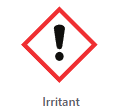 |
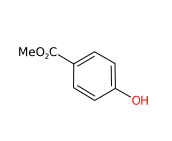 | 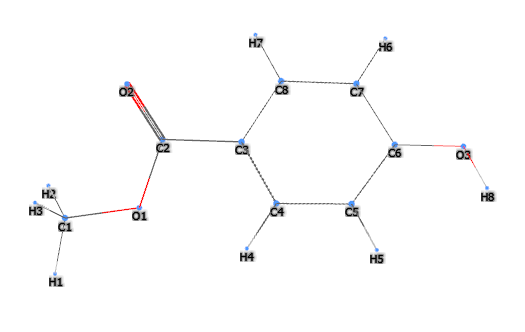 |
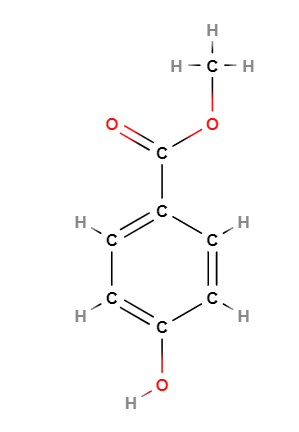 | 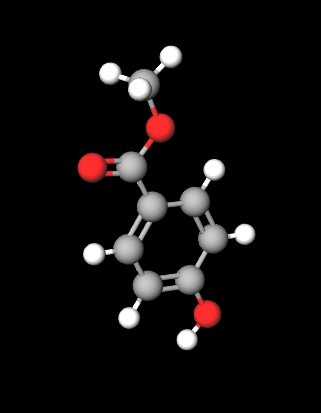 |
Price
$2.10 - $10.40/ kg
- Molecular Formula C8H8O3
- Linear Formula HOC6H4CO2CH3
- Molecular Weight 152.15
- CAS 99-76-3
- UNII A2I8C7HI9T
- EC Number 202-785-7
- DSSTox Substance ID DTXSID4022529
- IUPAC methyl 4-hydroxybenzoate
- InChl=1S/C8H8O3/c1-11-8(10)6-2-4-7(9)5-3-6/h2-5,9H,1H3
- InChl Key LXCFILQKKLGQFO-UHFFFAOYSA-N
- SMILES COC(=O)C1=CC=C(C=C1)O
- MDL number MFCD00002352
- PubChem Substance ID 329815219
- ChEBI 31835
- RTECS DH2450000
- Beilstein 509801
- FEMA 2710
- RXCUI 29903
- NSC 406127 3827
- NACRES NA.25
Synonyms :
- E218
- Sodium Methylparaben
- Methylparaben
- Solparol
- Metilparaidrossibenzoato
- Methyl-4-hydroxybenzoate
- p-Hydroxybenzoic acid methyl ester
- methyl para-hydroxybenzoate
- Metagin
- NIPAGIN
- p-Hydroxybenzoic acid, methyl ester
- p-Hydroxybenzoic methyl ester
- Methyl parasept
- Tegosept M
- 4-Hydroxybenzoic acid methylester
- 4-Hydroxybenzoic Acid Methyl Ester
- 4-(Methoxycarbonyl)phenol
- Methyl parahydroxybenzoate
References______________________________________
(1) Cha HJ, Bae S, Kim K, Kwon SB, An IS, Ahn KJ, Ryu J, Kim HS, Ye SK, Kim BH, An S. Overdosage of methylparaben induces cellular senescence in vitro and in vivo. J Invest Dermatol. 2015 Feb;135(2):609-612. doi: 10.1038/jid.2014.405.
(2) Terasaki M, Abe R, Makino M, Tatarazako N. Chronic toxicity of parabens and their chlorinated by-products in Ceriodaphnia dubia. Environ Toxicol. 2015 May-Jun;30(6):664-73. doi: 10.1002/tox.21944.
Popa DS, Bolfa P, Kiss B, Vlase L, Păltinean R, Pop A, Cătoi C, Crişan G, Loghin F. Influence of Genista tinctoria L. or methylparaben on subchronic toxicity of bisphenol A in rats. Biomed Environ Sci. 2014 Feb;27(2):85-96. doi: 10.3967/bes2014.021.
(3) Lee J, Park N, Kho Y, Lee K, Ji K. Phototoxicity and chronic toxicity of methyl paraben and 1,2-hexanediol in Daphnia magna. Ecotoxicology. 2017 Jan;26(1):81-89. doi: 10.1007/s10646-016-1743-6.
(4) Martins RC, Gmurek M, Rossi AF, Corceiro V, Costa R, Quinta-Ferreira ME, Ledakowicz S, Quinta-Ferreira RM. Application of Fenton oxidation to reduce the toxicity of mixed parabens. Water Sci Technol. 2016 Oct;74(8):1867-1875. doi: 10.2166/wst.2016.374.
(5) Lillo MA, Nichols C, Perry C, Runke S, Krutilina R, Seagroves TN, Miranda-Carboni GA, Krum SA. Methylparaben stimulates tumor initiating cells in ER+ breast cancer models. J Appl Toxicol. 2017 Apr;37(4):417-425. doi: 10.1002/jat.3374.
(6) Hu P, Kennedy RC, Chen X, Zhang J, Shen CL, Chen J, Zhao L. Differential effects on adiposity and serum marker of bone formation by post-weaning exposure to methylparaben and butylparaben. Environ Sci Pollut Res Int. 2016 Nov;23(21):21957-21968. doi: 10.1007/s11356-016-7452-0.
(7) Hu P, Chen X, Whitener RJ, Boder ET, Jones JO, Porollo A, Chen J, Zhao L. Effects of parabens on adipocyte differentiation. Toxicol Sci. 2013 Jan;131(1):56-70. doi: 10.1093/toxsci/kfs262.
(8) Baker BH, Wu H, Laue HE, Boivin A, Gillet V, Langlois MF, Bellenger JP, Baccarelli AA, Takser L. Methylparaben in meconium and risk of maternal thyroid dysfunction, adverse birth outcomes, and Attention-Deficit Hyperactivity Disorder (ADHD). Environ Int. 2020 Jun;139:105716. doi: 10.1016/j.envint.2020.105716.
(9) Matwiejczuk N, Galicka A, Zaręba I, Brzóska MM. The Protective Effect of Rosmarinic Acid Against Unfavorable Influence of Methylparaben and Propylparaben on Collagen in Human Skin Fibroblasts. Nutrients. 2020 May 1;12(5):1282. doi: 10.3390/nu12051282.
| Evaluate |

